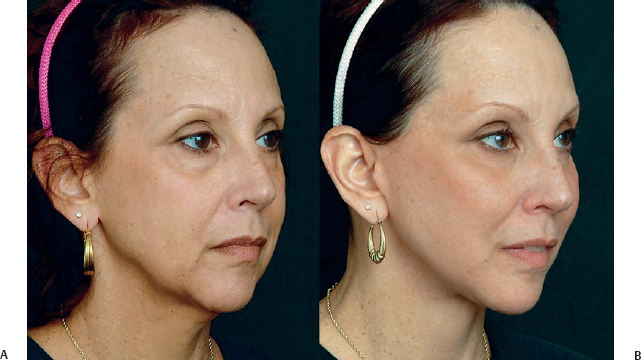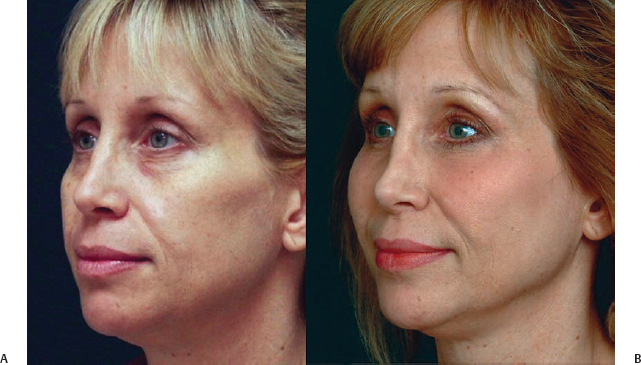12
Complementary Fat Grafting
Samuel M. Lam, Mark J. Glasgold, and Robert A. Glasgold
Volume loss has become increasingly recognized as a vital component to the aging process.1–3 Facial lifting procedures and skin resurfacing alone cannot address all aspects of aging. Autologous fat transfer has assumed an integral and important role in the authors’ respective practices as part of a comprehensive strategy toward facial rejuvenation. A metaphor that can help the surgeon and the prospective patient understand the utility of facial fat grafting is the grape, raisin, and pea. In youth, we are full and ripe grapes. As we age, the volume depletion turns us into raisins. Why then should we cut and pull that raisin, transforming it into a pea, which does not resemble a grape at all? Instead, we should reinflate that raisin back into a youthful grape. Obviously, this reductionist philosophy is not meant to imply a monolithic perspective on the aging process. The title of this chapter, “Complementary Fat Grafting,” emphasizes the complementary nature of fat grafting to traditional lifting procedures to attain optimal aesthetic outcomes. Overfilling the face to manage pseudoherniation of fat in the lower eyelid or a ptotic jaw line may lead to unnecessarily long recovery times and, worse yet, unfavorable results. Judicious combination of fat grafting with conservative blepharoplasty and/or a facelift in the appropriate clinical circumstance can yield superior outcomes (Fig. 12.1).
A useful adjunct for understanding the importance of volume restoration with autologous fat transfer is to review with the patients photographs of themselves when they were younger. Youthful photographs of the patient can help formulate a surgical plan to achieve a natural-appearing result. These photographs can also help a prospective patient truly understand the dynamic role that volume loss has played in the process of facial aging. The two predominant features that will become obvious to the patient and surgeon when reviewing old photographs are the presence of a youthful fullness that frames the eyes and the volume and shape that is characteristic of a youthful face. Alternatively, if such photos are unavailable, then it is also useful to review photos of young individuals to help the patient understand what constitutes a youthful appearance and to establish the appropriate surgical goals for that individual.

Fig. 12.1 (A) Preoperative photo. (B) Postoperative photo after fat transfer to the inferior orbital rim and midface, in conjunction with a lower lid transconjunctival blepharoplasty and facelift.

Fig. 12.2 (A) Preoperative and (B) postoperative photos demonstrate how a full periorbital frame is obtained through conservative blepharoplasty in conjunction with periorbital and midface fat transfer.
Traditional blepharoplasty that hollows the orbit through aggressive removal of fat and skin will generally result in a skeletonized eye, making it look surgically “done,” not younger. Adding fat to the periorbital region returns the fuller, volumetric frame that circumscribes and defines youthful eyes (Fig. 12.2). The approach we take is to combine the fat transfer procedure with a conservative lower lid transconjunctival blepharoplasty. Rejuvenation of the upper lid will generally consist of a skin-only blepharoplasty with fat transfer to the superior orbital rim and, if very sunken, the upper lid. Brow lifting is generally avoided in most of our patients as it further hollows out the eye. Examination of young individuals will reveal that most do not have the high-set brows with a sculpted superior orbital rim that is typically seen after a brow lift.4 With aging, the brow does not typically descend, it in fact begins to deflate and thereby appears to sag. Reinflation of the brow with fat grafting oftentimes can help restore a patient back to the way he or she used to look.
A youthful face has a characteristic heart shape, with highlights that fall along the prominence of the cheeks and the chin to create this ideal, triangular-shaped face. With advancing age, the cheeks and chin as well as other areas deflate and the jowls gradually become more prominent, transforming that ideal triangle into more of a square or rectangular shape. This change in shape not only is unflattering but also imparts a more masculinized appearance to the female face. For men who desire fat grafting, the anterior cheek should not be overly inflated, as it is a hallmark of youthful femininity. By contrast, the lateral cheek may be more suitably enhanced in the male patient to maintain a more masculine countenance. Besides reaugmenting the apices of the triangle with facial fat grafting, the jowls can be lifted via a facelift to complete the transformation back toward a youthful triangular facial configuration (Fig. 12.3). Brow lifting is rarely indicated in our volumetric approach as it tends to lengthen the female face, which accents the aging, squared-off appearance. Framing the eye with fat grafting and restoring the shape back into a youthful triangle are the two major objectives in facial rejuvenation.
In our experience, the two areas that have not been ideal for autologous fat transfer are the lips and the deep facial lines and folds. The amount of adipocyte survival tends to be less in these hyperdynamic areas. Lip enhancement with fat grafting involves a protracted and deforming recuperation. Augmentation of the nasolabial and labiomandibular folds proves to be disappointing in achieving a perceived and durable benefit. In patients undergoing facial fat transfer we will generally transfer fat into these folds so that the augmented malar and chin regions blend favorably along these lines but not in fact to actually efface these lines or folds. Other dermal fillers are preferred to achieve a perceivable benefit for lip enhancement and attenuation of facial lines and folds.
One of the critical questions raised regarding fat transfer is the durability of the result. Our experience is that the amount of fat that survives the transfer is variable, but there is always some degree of viable fat that will persist for many years. We counsel prospective patients that the variable fat graft survival means it will often take two and possibly three transfers to achieve the desired result. Once that result is achieved, it is for all intents a permanent effect.

Fig. 12.3 (A) Preoperatively, this patient had an aging appearance, with a squaring off of her facial shape due to volume loss in the midface and the presence of jowls. (B) A more youthful heart shape is created through the combination of fat transfer to the periorbital area and cheeks and a facelift.
♦ Operative Technique
Anesthesia Considerations
Autologous fat transfer can be undertaken with almost any level of anesthesia (i.e., from straight local to general anesthesia). We prefer light conscious sedation for patient comfort and to facilitate patient repositioning, if needed, for fat harvesting.
For recipient-site anesthesia, the three primary entry sites used on each side are anesthetized, and a regional nerve block is administered with 1% lidocaine and 1:100,000 epinephrine (Fig. 12.4
Stay updated, free articles. Join our Telegram channel

Full access? Get Clinical Tree








